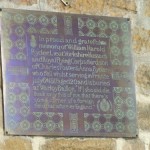Eliza Grant
Eliza is another casualty of The Great War who rests within yards of where we sit today. Eliza was not in the military, a nursing profession, or an aid worker. Yet her death was as a direct result of war.
.Eliza Hammond was born into a mining family in Castleford in 1876.
.Eliza, aged 23, married widower Clayton Dixon Grant in this church on 22 May 1899, 126 years ago.
In 1911, the Grant family lived on William Street, off Lock Lane, Castleford, in one of the many rows of houses occupied by local miners. Eliza looked after her children and at least two step-children.#
Sometime in 1916, Eliza went to work at Barnbow, Crossgates.

Map of Barnbow
The declaration of war with Germany on 3 August 1914 created an urgent need for large volumes of arms/ammunition. However, few establishments, apart from Woolwich Arsenal, were involved in this work, especially by mass production. An early initiative was taken by Leeds commerce and the city’s major firms, with the newly formed Leeds Munitions Committee quickly promoting the production of shells at Leeds Forge Company, Armley. Works at Hunslet and Newlay (Horsforth) followed suit. A directing board comprising six Leeds citizens, charged with constructing the First National Shell Filling Factory, met in August 1915. A site between Crossgates and Garforth, part of the Gascoigne estate, was selected at Barnbow between Crossgates and Garforth.
.The leading site, initially some 313 acres (later increased to 400 acres), extended along the eastern part of Manston Lane, embracing two farms at Shippen and Lazencroft. The North Eastern Railway was along the southern boundary. Possessions cleared away from the site were sold by auction, and the construction plant and materials were quickly transported from Leeds. The site soon increased electricity and quickly added water and wastewater facilities.
.The site also had a farm that produced milk for the factory workers.
The Ministry of Munitions’ decision to install an AMATOL factory at Barnbow instead of Otley began the erection of the melting house building—AMATOL ‘B’—in March 1916. In April, the first batch of thirty 4.5 shells was filled, and the output quickly increased to 6000 shells a day when the number of shifts was increased from two to three.
In the AMATOL factory, 12,000 tons of tri-nitro-toluene (TNT) was mixed with 26,350 tons of ammonium nitrate to produce the highly explosive ‘AMATOL’ compound. In the cartridge factory, 61,000 tons of propellant were made into breech-loading charges made up of NCT and cordite, the material having been weighed out in ounces and parts of an ounce. Working with cordite for long periods caused the skin of the operatives to turn yellow; the cure for this was drinking plenty of milk.
.To recruit a large workforce, an employment bureau was opened at the Wellesley Building in Leeds, and the first batch of employees received one month’s training at Woolwich. Training was subsequently undertaken at Barnbow, and after preliminary trials in December 1915, filling operations began, continuing thereafter without a break. One-third of the workers came from Leeds, others from Castleford, Wakefield, Harrogate, Knaresborough, Selby, York, Tadcaster, Wetherby and many outlying villages. Three 8-hour shifts were adopted: 6.00 – 2.00 pm, 2.00 – 10.00 pm and 10.00 – 6.00 am. Work was usually done 6 days a week, with Saturday off every 3 weeks; no holidays were taken. In October 1916, with a workforce of some 16,000, a new production bonus scheme was introduced, which identified ineffective operations. Thereafter, the number of workers declined to about 9,000, although 9 months later, production increased. A typical munition worker’s earnings for a full week averaged £3.0s.0d, and the girls who swept up waste for recycling (droppings after shell assembly) earned £1.17s.0d a week. Workers in the danger/powder room received extra pay. At one period, wages totalled £24,000 per week, and it was claimed that the cost of producing munitions at Barnbow compared favourably with any other similar factory in the country.
.The first explosion (there were two further explosions) took place in one of the fusing rooms on the night of 5 December 1916, where it is said that 35 women lost their lives. Some of these 35 women died as a result of their injuries later.
Due to censorship, no account of the accidents was made public; however, Field Marshall Sir Douglas Haig, in a special order of the day issued from the British HQ in France, paid tribute to the devotion and sacrifice of the munitions workers. A Roll of Honour, ‘They Died Serving’, records the names of all factory workers who lost their lives in the three explosions. The name of Ethel Agnes Jackson, who was killed in the blast in December 1916, heads the list of wartime casualties on the roll of honour in the Colton Methodist Church.
.Eliza, along with Jane Few, Edith Levitt and Olive Yeates, died in Leeds Infirmary on 6 December 1916; some of the girls and ladies who did not die at Barnbow.
 .Some of the death certificates of the casualties give their cause of death as ‘Shock due to injuries to vital organs caused accidentally by an explosion in a shell factory’. This shows that although there were many mutilated bodies, the force of the explosion caused catastrophic trauma.
.Some of the death certificates of the casualties give their cause of death as ‘Shock due to injuries to vital organs caused accidentally by an explosion in a shell factory’. This shows that although there were many mutilated bodies, the force of the explosion caused catastrophic trauma.
Sources:
Ancestry; British Newspaper Archive; The Great War Forum;
Anne Batchelor from her book ‘The Barnbow Canaries’.
http://www.barwickinelmethistoricalsociety.com/4746.html






